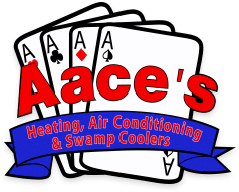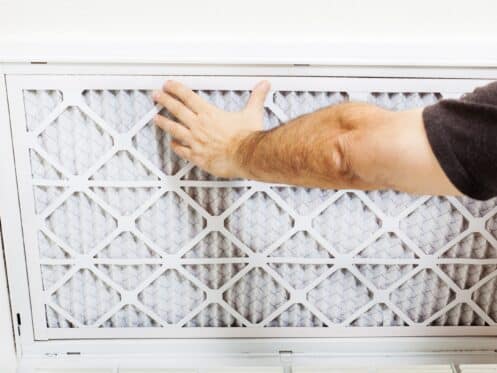HVAC air filters are designed to prevent damage and avoid issues that can result from dust and debris getting inside the system. When your heating or air conditioning is running, the blower pulls air through the filter so that any dust and debris gets trapped and can’t get inside the furnace or air handler. Replacing or washing the air filter is one of the most essential HVAC maintenance tasks, and this guide will show you everything you need to know about how this is done and why it’s important.
Disposable vs. Washable Filters
Both disposable and washable HVAC air filters can be equally as effective depending on the filter rating, and the choice between the two is typically a matter of price versus convenience. The majority of homeowners opt to use disposable filters simply because they’re more convenient. Whenever the filter gets dirty, all you need to do is toss it in the trash and insert the new clean filter in its place. It’s important to note that disposable filters come in a wider range of MERV ratings, which measures their effectiveness in filtering airborne contaminants. Most washable filters do not offer very high MERV ratings, so they are typically not the ideal option for indoor air quality purposes.
Reusable or washable filters do require a bit more work, but can be the cheaper option in the long term. You can typically use the same washable filter for around five years before you need to buy a new one. Most high-quality washable filters cost somewhere between $50 and $80. That’s around the same price as you’d pay for a six-pack of disposable filters that would only last you a year or two on average.
If the washable filter is only slightly dirty, you can usually just use a vacuum with a brush attachment to gently clean off any dirt and debris before putting the filter back in place. If you vacuum the filter off every month, you’ll usually only need to thoroughly wash and clean it a few times a year.
When the filter starts getting too dirty, you’ll want to put it in a sink and first rinse as much debris off as you can with water. You can also take it outside and clean it with your hose if you’re worried about making a mess. After rinsing it off, you should then use a soft-bristled brush and warm, soapy water to gently scrub the filter to remove any caked-on debris. Depending on how dirty the filter is, you may need to rinse and scrub it a few more times until it is fully clean.
Once the filter is clean, you should shake off as much excess water as you can and then set it aside until it fully dries. Making sure that the filter is completely dry before putting it back in place is important as mold and mildew may quickly start growing on it if you put it back when it’s still wet.
How To Properly Insert an Air Filter
No matter whether you use a disposable or washable filter, you always need to pay attention and make sure you put the filter in so that it’s facing the correct direction. All filters are directional, which means they only work if the air flows through the front or face of the filter. If you put the filter in facing the wrong direction, it will have almost zero effect and allow lots of dust to get inside your furnace and air handler.
When looking at the filter, you will always see an arrow that points in the direction that the air needs to flow through it for it to be effective. If your filter is located in the return plenum, you need to put the filter in so that the arrow points toward the furnace and air handler. For filters located behind the return air vent, the arrow should point away from you and toward the inside of the air duct.
How Often Should an Air Filter Be Cleaned or Replaced?
Exactly how often your air filter will need to be cleaned or replaced depends in large part on how much your heating or air conditioning is running. The more hours per day that your HVAC system runs, the quicker the filter will get dirty and start to clog.
Generally speaking, you should never go for longer than three months without washing the filter or replacing it. During the milder parts of the year when your HVAC system doesn’t get as much use, you’re usually fine to replace or wash the filter every two or three months.
During the hottest and coldest parts of the year when your AC or heating runs two or three times an hour throughout most of the day and night, you’re often better off replacing or cleaning the filter every four to six weeks. You will also want to wash or replace the filter more frequently if you have pets in the home as all of the hair and dander that they shed will clog up the filter more quickly.
You may also need to clean or replace the filter more often if you live in an older home. Modern homes tend to be much better built and have an exterior envelope that is almost completely airtight. Older homes usually have quite a few leaks in the envelope that allow air as well as dust and pollen to get inside, which can also result in the filter clogging up more quickly.
If anyone in your home suffers from allergies or has asthma, you should always use a higher-rated filter and replace it every month or so. This will help to minimize the amount of pollen and other allergens that circulate around the home when your HVAC system runs.
Benefits of Cleaning or Replacing Your Filter Regularly
Regularly replacing or cleaning your air filter is important for the effective operation of your HVAC system and can help lower your heating and cooling costs. A clogged filter restricts the airflow through the system, making your HVAC work harder and causing more wear and tear. This results in longer heating or cooling cycles and increased energy consumption. Neglecting filter maintenance can lead to more frequent repairs and premature HVAC unit failure. To ensure your system runs smoothly, remember to clean or replace your air filter as recommended by the manufacturer.
A clogged filter can even cause your heating or air conditioning system to stop working altogether. When airflow is restricted, the furnace can’t disperse heat efficiently, potentially causing overheating and automatic shutdown. Similarly, restricted airflow in your AC system can slow down the capture of heat by the refrigerant, leading to ice formation on the evaporator coil and system freezing. Overheating and freezing are critical problems that can result in significant damage, making them issues you’ll want to prevent.
Prolongs the Life of Your HVAC Equipment
As one of the top-rated HVAC companies in the Victorville area, Aace's Heating, Air Conditioning & Swamp Coolers is ready to take care of all of your home’s heating and air conditioning needs. Our certified technicians specialize in all types of HVAC repairs as well as maintenance and installation, and we can also assist with your indoor air quality needs or if you need any swamp cooler services.
Give us a call today if you have any questions about your home’s air filter or to schedule any AC or heating service.






